Empower Your Strength Journey
Strength training over 50 is not only possible – it’s a game-changer for healthy aging. Far from being a time to slow down, your fifties and beyond can be your strongest years yet. By lifting weights or doing resistance exercises, you can rebuild muscle, strengthen bones, and boost your energy and confidence. Best of all, science shows that regular strength training after 50 can add vibrant years to your life.
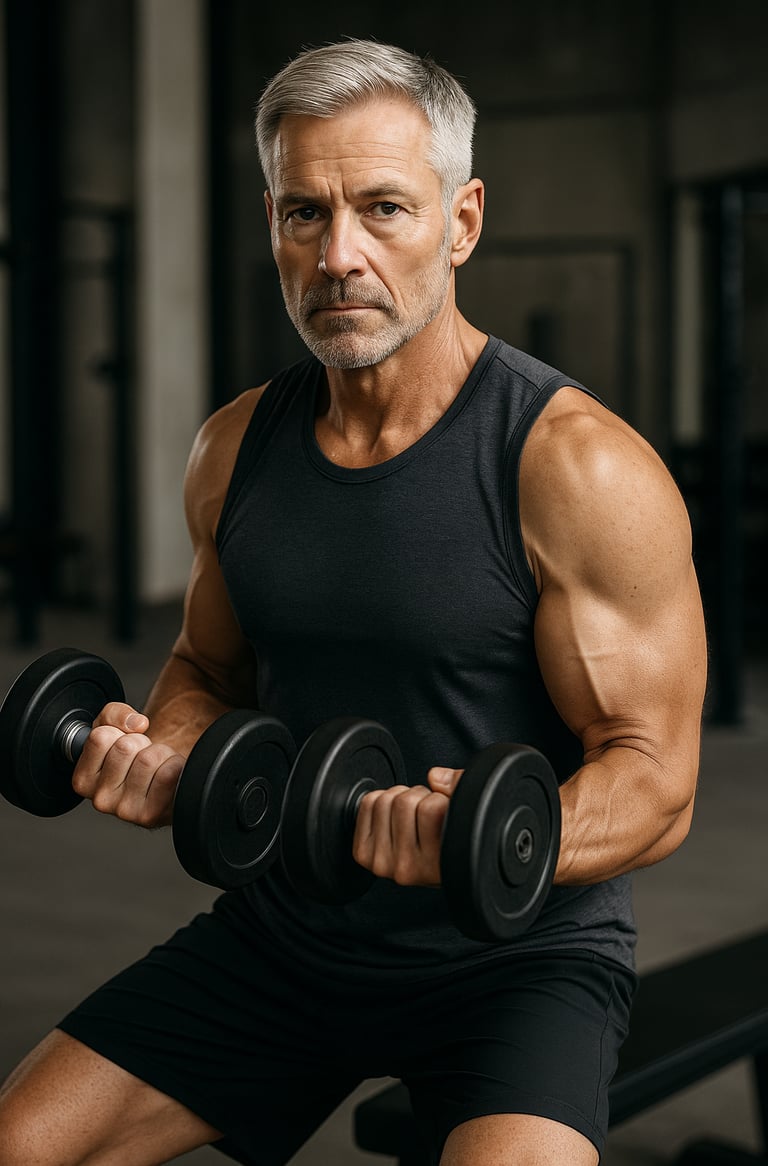

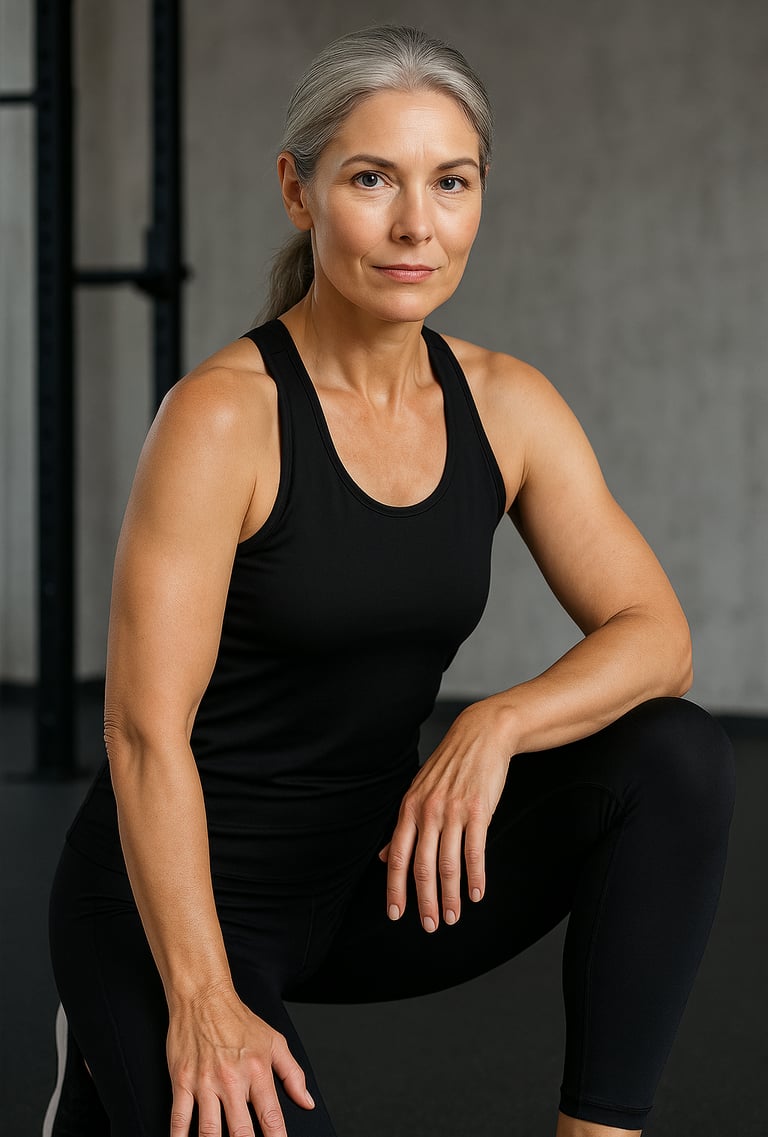

Strength Training Over 50
A Plan for Longevity and Vitality
Discover how strength training can rebuild muscle, strengthen bones, and boost your energy. Start your journey to a vibrant life today.
The Power of Strength Training in Your 50s
Regular strength training can help people over 50 stay strong, confident, and independent as they age. For many adults, growing older seems to involve an inevitable loss of strength, energy, and vigor. But research shows it doesn’t have to be that way cdc.gov. Much of the weakness we associate with aging is actually due to muscle loss from inactivity – a condition known as sarcopenia pubmed.ncbi.nlm.nih.gov. Starting in middle age, people who don’t exercise can lose 1–2% of their muscle mass each year, leading to frailty over time. The encouraging news is that if you “use it,” you can avoid losing it – strength training allows you to preserve and even rebuild muscle at any age. Studies at Tufts University and elsewhere have shown that consistent strength exercise fights off the typical weakness and frailty of aging, helping to maintain your independence and energy. These exercises are safe and effective for women and men over 50, and even those with chronic health issues like arthritis or heart disease often benefit the most from strength training. In other words, no matter how old you are, you do not have to get weaker with age – you can get stronger instead.
Strength training is truly a longevity secret. Building muscle and strength doesn’t just make day-to-day life easier – it may actually help you live longer. Large studies have found that older adults who did strength training at least twice per week had significantly lower mortality rates than those who did none. In one survey of over 115,000 people, those who added two or more days of strength exercises to their weekly routine reduced their risk of death by about 30% over an 8-year period health.harvard.edu. Similarly, a recent analysis focusing on women reported that those doing muscle-strengthening workouts a few times per week had a 30% lower risk of dying from heart disease compared to women who skipped strength training. These are profound effects – few other lifestyle changes cut mortality risk by a third! The evidence is clear: maintaining your muscle through resistance exercise is a game-changer for healthy aging and longevity.
Physical Benefits: A Stronger Body for a Longer Life
Strength training doesn’t just build muscles – it bolsters nearly every system in the body. Especially as we get past 50, regular strength exercise yields a wide range of physical health benefits:
Joint Health (Arthritis): Weight training helps reduce arthritis pain and stiffness, while increasing joint strength and flexibility. By strengthening the muscles around your joints, it provides better support and can ease the strain that causes aches.
Blood Sugar Control (Diabetes): Resistance workouts improve your body’s insulin sensitivity and glycemic control, which helps manage blood sugar levels. In fact, studies have shown significant improvements in blood glucose regulation after several weeks of strength training in people with type 2 diabetes.
Bone Density (Osteoporosis & Falls): Lifting weights or doing resistance exercises increases bone density and strength. This is crucial after 50, particularly for women, as it helps prevent osteoporosis and fractures. Stronger muscles and bones together also improve balance – reducing the risk of falls that can lead to serious injuries.
Heart Health: Strength training is a heart-healthy habit. It lowers cardiovascular risk by improving cholesterol profiles and overall fitness. When combined with aerobic exercise, it can help lower blood pressure and enhance circulation, providing a one-two punch for protecting your heart.
Weight Management: Building muscle boosts your metabolism. Muscle tissue burns more calories at rest, which means strength training helps you increase your basal metabolic rate. Over time, this makes it easier to maintain a healthy weight and avoid the creeping fat gain that often occurs with age. Many people find that adding weight training helps reshape their body and burn more calories even when they’re not exercising.
Back and Core Strength: By strengthening the back, core, and abdominal muscles, resistance training can alleviate chronic back pain and improve posture. A stronger core means everyday tasks – from carrying groceries to climbing stairs – become easier and put less strain on your spine.
In short, a consistent strength-training routine fortifies your body and helps turn back the clock on many age-related problems. You’ll move easier, with less pain, better balance, and more stamina. It’s an investment in staying physically capable and resilient as you grow older, setting the foundation for a longer healthspan (years of healthy life). Your muscles truly are “use it or lose it” assets – and by using them, you’re actively protecting your health for the long haul.
Mental and Emotional Benefits of Strength Training
The benefits of strength training aren’t just physical – they extend to your mind and mood, contributing hugely to vitality in your 50s and beyond. Exercise of any kind triggers the release of endorphins and other brain chemicals that improve mood, and resistance training is no exception. In fact, a strong body helps build a stronger, happier mind. Research backs this up: a 2018 meta-analysis of over 30 clinical trials found a significant reduction in symptoms of depression among people who did weight training at least twice a week. In some studies, strength training even outperformed aerobic exercise for improving mood in depressed patients. There’s also evidence that it can alleviate anxiety – participants report feeling less anxious and more self-assured after a bout of resistance exercise npr.org. The act of mastering new exercises and gradually lifting heavier weights can provide a sense of accomplishment that carries over into everyday life, reducing stress and improving mental resilience.
Strength training may also give your brain a boost in more concrete ways. Scientists are exploring the link between exercise and cognitive function, and the findings are promising. Regular resistance training appears to improve memory and thinking skills in older adults. One review of intervention studies concluded that consistent strength training led to significantly better overall cognitive function in both healthy older individuals and those with mild cognitive impairment pubmed.ncbi.nlm.nih.gov. In other words, working your muscles also works out your brain – possibly slowing cognitive decline and lowering the risk of conditions like dementia. On a simpler level, staying strong keeps you mentally sharp by enabling you to continue engaging in activities you love (gardening, traveling, playing with grandkids), which keeps the mind active.
Equally important are the confidence and self-esteem gains that come with getting stronger. Many people over 50 start to feel “old” because they notice their strength or abilities declining – but when you reverse that trend, it’s incredibly empowering. Research has found that strength training can reduce feelings of depression and boost self-confidence and self-esteem in older adults. You start to trust your body again, knowing that you’re capable of lifting, carrying, and moving with ease. This confidence often translates into a more positive outlook on aging. Strength training can even improve sleep quality: people who exercise regularly tend to sleep more deeply and wake less often at night, which means more energy and clearer thinking during the day. All these mental and emotional benefits add up to a happier, more vibrant life. You’re not just building muscle – you’re building a mindset that keeps you young at heart.


Getting Started: Strength Training Safely After 50
If you’re new to strength training or it’s been a long time, you might be wondering how to begin – especially in your 50s or 60s. The great news is that it’s never too late to start, and with some sensible precautions, strength training is remarkably safe for older adults. Studies have shown that even in supervised programs for people in their 70s and 80s, serious injuries are rare to nonexistent pmc.ncbi.nlm.nih.gov. In fact, experts note that resistance exercise is safe even for people with health problems, and those with conditions like arthritis, diabetes, or heart disease often see big improvements when they adopt strength training. Of course, if you have a significant medical condition or you’ve been completely sedentary, it’s wise to consult your doctor before starting any new exercise regimen. Once you have the go-ahead, keep the following tips in mind to ensure you build strength safely and effectively:
Warm Up First: Always warm up before you strength train. Cold muscles are less flexible and more prone to strain. Spend about 5–10 minutes on light cardio to get your blood flowing – for instance, brisk walking, cycling on a stationary bike, or simple calisthenics. Warming up raises your muscle temperature and improves range of motion, preparing your body for the work to come. Likewise, cooling down with some gentle stretching after your workout can help reduce muscle soreness and keep you flexible.
Start Small: If you’re a true beginner, start with light weights or even just your bodyweight. You don’t need heavy iron to get results initially – exercises like chair squats (standing up from a chair) or body weight squats, wall push-ups, or lifting soup cans can start waking up your muscles. Resistance bands are another excellent, low-impact tool for beginners. The key for Day One is to avoid doing too much. It’s okay to begin with only 1 set of 8–10 repetitions per exercise. You will have plenty of time to increase the challenge as you gain confidence.
Focus on Form: Good form is far more important than how much weight you lift, especially in the beginning. Move in a slow, controlled manner and concentrate on the muscle you’re working. For example, if you’re doing a squat, keep your knees aligned over your toes and push your hips back as if sitting down. If you’re unsure about technique, consider asking a trainer or watching instructional videos from reputable sources. Proper form not only prevents injuries, it also ensures you’re actually targeting the right muscles.
Progress Gradually: Patience is key. In the beginning, less is more – you want to master the basics and allow your body to adapt. As you grow stronger, you can gradually increase the difficulty. A good rule of thumb is: once you can comfortably perform more than ~10–12 repetitions of an exercise in good form, consider increasing the weight slightly. For example, if you’ve been doing 10 reps of biceps curls with a 5-pound weight and it feels easy, try using an 8-pound weight or doing 12–15 reps with 5 pounds. Small, incremental progressions will accumulate big gains over time. Avoid the temptation to jump up in weight too fast – your muscles, tendons, and joints will thank you.
Schedule Recovery: Rest and recovery are an essential part of strength training, especially as you get older. Muscles actually get stronger between workouts, during the rest period when they repair and adapt. Make sure to give yourself at least 48 hours before working the same muscle group again. Many people over 50 find that doing full-body strength sessions twice a week (with days off in between) is ideal for recovery. On off-days, you can do light cardio or simply rest. Listen to your body – if you’re feeling excessively sore, give yourself an extra day before the next session. Adequate sleep and good nutrition (including enough protein) will also help your muscles recover and grow.
Listen to Your Body: Expect some muscle soreness when you’re getting started – that’s normal, and it’s a sign your muscles are adapting. However, sharp or sudden pain is a red flag. Distinguish between the “good” burn of muscle fatigue and any joint pain or injury-like pain. If something hurts in a bad way, stop that exercise. You might need to modify the movement or seek guidance on form. It’s okay to challenge yourself, but never at the expense of pain. Over time, you’ll learn the difference between discomfort from effort and pain from strain. Always err on the side of caution in the beginning.
Consider Guidance: Especially for those new to exercise, a session or two with a certified personal trainer (or a physical therapist familiar with exercise programs) can be incredibly helpful. A professional can design a program tailored to your abilities and goals, teach you proper form, and give you the confidence to continue on your own. If joining a gym or hiring a trainer isn’t an option, look for community center classes or reputable online programs aimed at older adults. Having some guidance can jump-start your progress and ensure you’re doing exercises safely.
Stay Consistent: The most important principle of all is consistency. Improvements in strength and health come from making training a regular habit. Aim for at least two days per week of strength workouts to start – mark them on your calendar. Treat them as important appointments with yourself. Consistency beats intensity for long-term success: moderate workouts done regularly will outperform sporadic extreme efforts every time. Find ways to keep yourself motivated – perhaps by tracking your progress in a journal, working out with a friend, or rewarding yourself for sticking to your routine. Over the weeks and months, those small steps add up to major changes. Remember that even in older adults with low initial fitness, significant improvement is possible with a consistent program.
By following these tips, you’ll create a safe foundation to build on. Many people in their 50s and 60s are surprised by how quickly they start noticing improvements – maybe it’s lifting a bag of groceries with ease or having better stamina working in the yard. Celebrate those wins. You’re proving that your body is capable of growth and change, no matter your age.
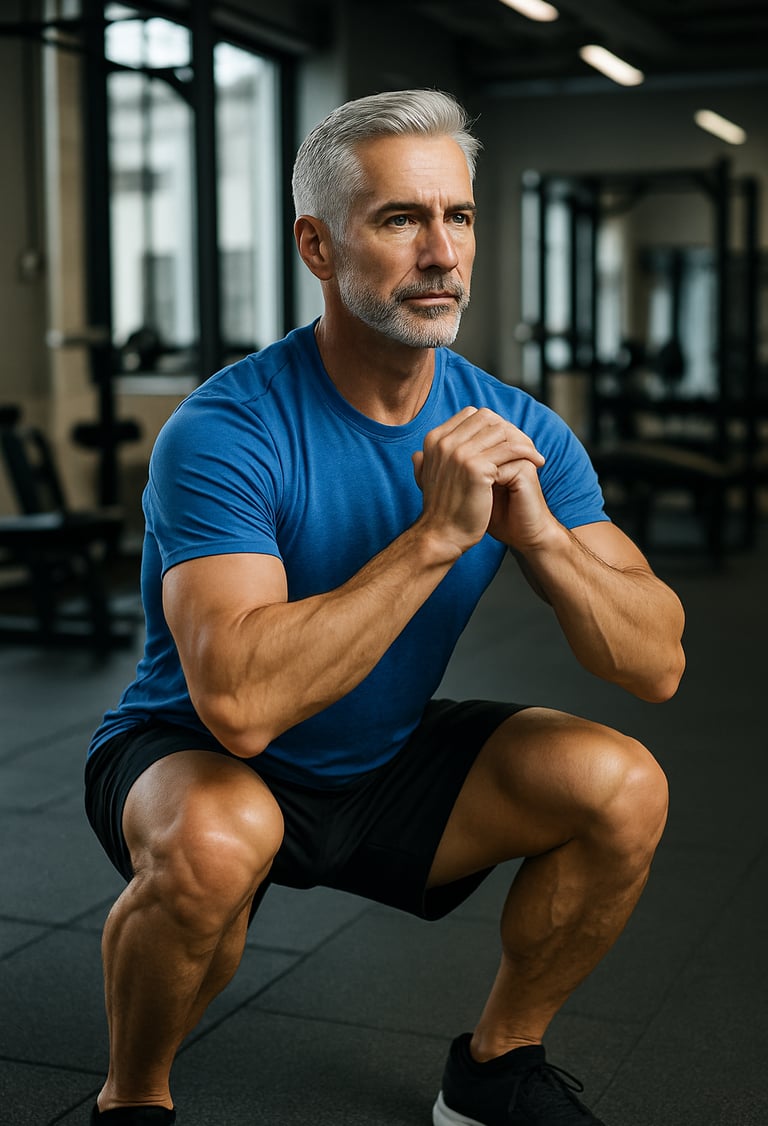

Building a Strength Training Plan for Longevity
What does an ideal “strength training for longevity” plan look like? First, it should align with established exercise guidelines for older adults. Experts recommend at least two days per week of muscle-strengthening activities for adults over 50 (and 65+), working all the major muscle groups cdc.gov. In practice, this might mean you do a full-body strength workout twice a week – for example, say Monday and Thursday. On those days, you’d aim to do exercises for your legs, hips, back, chest, abdomen (core), shoulders, and arms.
Each session could include moves like: squats or lunges for the legs, push-ups or chest presses for the chest and shoulders, rowing motions (resistance band rows or bent-over dumbbell rows) for the back, overhead presses for the shoulders, biceps curls and triceps extensions for the arms, and planks or bridges for the core. There are countless exercises to choose from, and you can certainly mix it up to keep things interesting – the key is that over the course of the week you engage every major muscle group. This ensures balanced strength development and full-body benefits.
For each exercise, a common recommendation is to perform about 8 to 12 repetitions per set, at a weight that makes the last couple of reps challenging to complete with good form. Beginners might start with just one set per exercise, and then gradually work up to 2–3 sets as their endurance improves. For instance, on a full-body day you might do 1–2 sets of 10 reps for each of 8 different exercises (covering the whole body). Including a short rest (say 1–2 minutes) between sets or exercises will help you maintain good form as you exercise. As you progress, you could add a third day of strength training or incorporate more variations, but remember: consistency beats volume.
A solid twice-weekly program that you stick with will beat a more aggressive program that you quit. Research suggests that even relatively minimal strength training – just a couple of sessions per week – can significantly improve strength and function in middle-aged and older adults, especially if they’re new to exercise pmc.ncbi.nlm.nih.gov. So you don’t need to spend hours in the gym or lift every day to reap the rewards; you just need to challenge your muscles regularly and progressively.
While strength training is the focus of this plan, a truly longevity-promoting routine will include other types of activity as well. Cardiovascular exercise is important for heart and lung health, circulation, and endurance. Try to get at least 150 minutes of moderate cardio per week (like brisk walking, cycling, swimming, or dancing), in line with standard guidelines. You can break this up however you like – for example, 30 minutes of brisk walking five days a week would meet this goal. If that sounds like a lot, remember that even smaller amounts of activity confer benefits, and you can build up over time.
Combining cardio with strength training produces the best outcomes: in fact, older adults who meet both the aerobic and muscle-strengthening recommendations have the lowest mortality risk of all. So think of cardio and strength work as two complementary parts of your longevity plan. In addition, don’t forget flexibility and balance training. Simple stretching exercises on most days can help you maintain joint range of motion and posture. And balance practices – such as tai chi, yoga, or even brief exercises like standing on one foot or heel-to-toe walking – are highly beneficial, especially to prevent falls as you get older.
Many strength exercises inherently improve balance and coordination, but it’s still useful to include dedicated balance exercises if you have any concerns in that area.
Putting it all together, a well-rounded weekly plan for someone over 50 might look like this:
Most days: Some aerobic activity (e.g. walking, biking, swimming) at a moderate intensity, totaling ~150 minutes for the week.
Two (or three) days a week: Strength training sessions, hitting all major muscle groups (e.g. one session could be Monday and another on Thursday).
Most days: Light flexibility work (stretching) and a few balance drills. These could be done after workouts or on rest days, and only take a few minutes.
Rest: At least 1–2 rest days per week (light walking or easy mobility work is fine on “rest” days). Adequate recovery optimizes your gains and keeps you from overtraining.
Of course, this template can be adjusted to fit your schedule and preferences. The best exercise plan is one that you enjoyand can maintain in the long term. Some people love going to a gym; others do bodyweight exercises at home or join a local class for seniors. As long as you are consistently challenging your muscles and staying active, you’re doing it right. Make it fun, make it yours, and make it sustainable. Over time, you’ll likely find that what started as a weekly routine becomes a treasured habit – time that you devote to your own well-being and healthy aging.
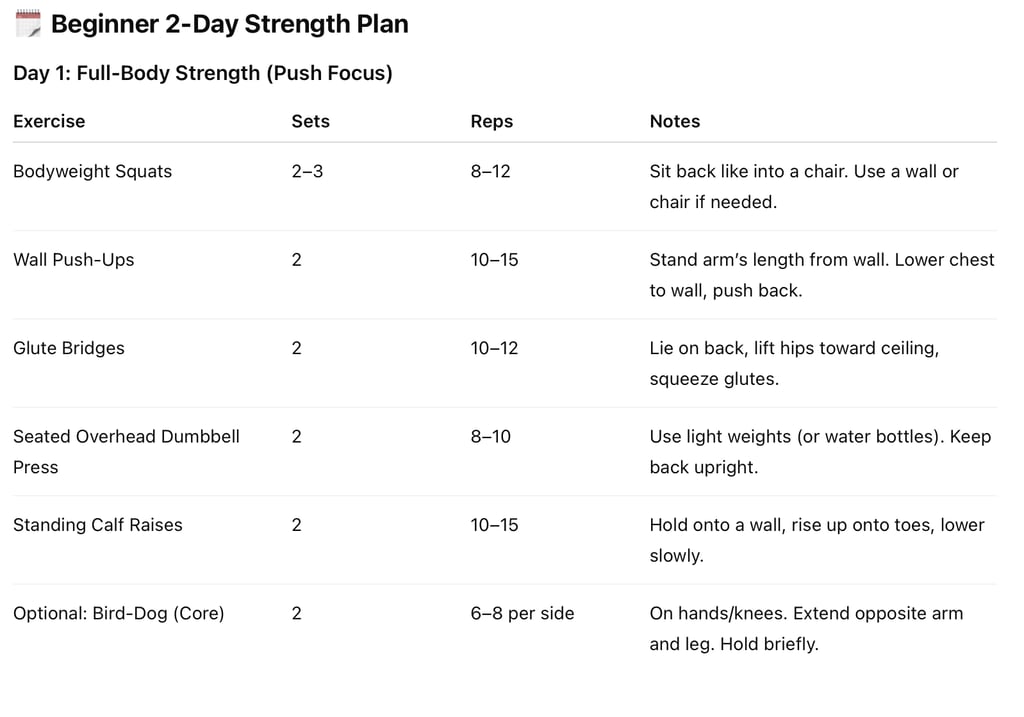

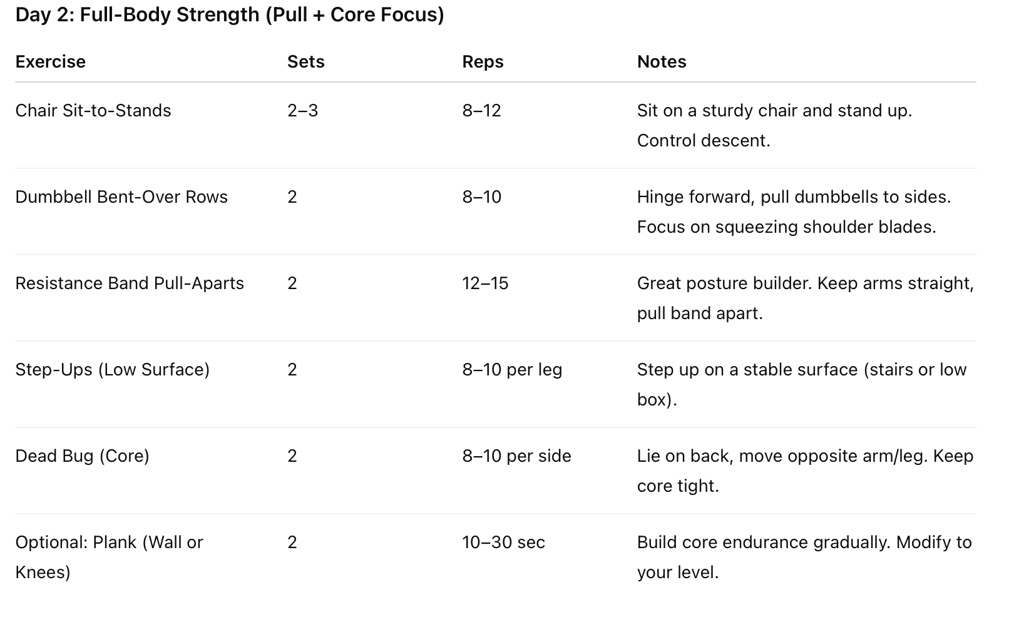

A Beginner 2-Day Strength Training Plan to Get You Moving
You don’t need to train every day or do hour-long sessions to start feeling stronger. The key is to keep it simple, safe, and consistent.
Below is a gentle but effective two-day plan that targets your whole body using just bodyweight, light dumbbells, or resistance bands. It’s designed to build confidence, not crush you — and it lays the foundation for everything that comes next.
Tips for Your First Week:
Rest 1–2 minutes between sets.
Start with one set per exercise if you’re unsure or deconditioned, and add sets as confidence grows.
Focus on slow, controlled movements.
You don’t need soreness to know it’s working. Consistency matters more than intensity at this stage.
Not Sure How to Do These Moves?
Don’t worry — you’re not alone. Most people feel unsure at the beginning. Fortunately, there are loads of clear, beginner-friendly video demonstrations available on YouTube. Just type the name of the exercise (e.g., “glute bridge for beginners” or “wall push-up tutorial”) and look for trustworthy channels that focus on form and safety.
You don’t need a personal trainer to get started — just a bit of curiosity and a willingness to learn. Watching a few videos can help you feel more confident with your technique and pacing.
The Long-Term Reward: Looking (and Feeling) Awesome at 50+
Many people are surprised when they see a vibrant, muscular 50-something woman or man lifting confidently in the gym. The truth is—this level of fitness is possible, but it doesn’t happen overnight. It’s the result of years of consistency, self-discipline, and a long-term commitment to health and training.
What you see in incredibly well-trained 50+ individuals isn’t just luck. It’s the reward of choosing strength again and again, even when it’s hard. It’s proof of what happens when you keep showing up — through busy schedules, setbacks, holidays, and life’s curveballs. Strength like that isn’t built in a 12-week challenge. It’s built over time — and it shows.
Let’s also be real: genetics play a role. Some people have muscle bellies that grow more easily, skin that stays tighter, or metabolisms that stay a little more cooperative.
Still, it’s important to remember: your best version may look different — and that’s not just okay, it’s the whole point. Maybe you won’t have the same definition or proportions, but what you will have is strength, energy, confidence and a body that serves you powerfully every day. You’ll stand taller. Move better. Feel younger.
So if your dream is to look sculpted and strong at 50+, go for it. Don’t let realism be an excuse for resignation. Let it be your motivation to build your own version of “awesome.” Every session you complete, every healthy choice you make, every bit of discipline you invest — it all adds up.
Because no matter your starting point, you can get stronger, leaner, and more vibrant than you thought possible. Not by chasing someone else’s physique — but by becoming the strongest, most capable version of you.


Conclusion: Lifelong Strength, Lifelong Vitality
Reaching 50 (and far beyond) can truly be the start of a new, empowered chapter in your life. Strength training offers a proven path to maintain and even increase your vitality as you age. Rather than resigning yourself to getting weaker or slowing down, you can take control of your health trajectory. The science is on your side: your muscles respond to training at any age, and your body can and will adapt in remarkable ways – growing stronger, fitter, and more resilient. By dedicating a couple of days each week to building strength, you’re investing in your independence and longevity.
Everyday tasks become easier, your risk of disease and injury drops, and you gain confidence that spills over into all aspects of life. It’s never too late to start reaping these benefits. The sooner you begin (or continue) a strength training routine, the sooner you’ll feel the positive effects – but even if you’re 70, 80, or 90, it’s still not too late to improve your strength and quality of life. So grab a pair of dumbbells or resistance bands, or simply use your own body weight, and get started on your journey to a stronger you. Stay consistent, progress gradually, and enjoy the process.
Strength training over 50 is not about chasing youth – it’s about embracing your right to a healthy, vibrant, and capable life at any age. Your future self will thank you for every workout you do today.
References
Harvard Health Publishing.
Strength training might lengthen life. Harvard Women’s Health Watch, 2023.
https://www.health.harvard.edu/staying-healthy/strength-training-might-lengthen-lifevon Haehling S, Morley JE, Anker SD.
An overview of sarcopenia: facts and numbers on prevalence and clinical impact. J Cachexia Sarcopenia Muscle. 2010;1(2):129–133.
https://pubmed.ncbi.nlm.nih.gov/21475695/Izquierdo M, Apell HJ, Häkkinen K, et al.
Multicomponent exercises including muscle power training enhance muscle mass, power output, and functional outcomes in institutionalized frail nonagenarians. Age (Dordr). 2014;36(4):9714.
https://pubmed.ncbi.nlm.nih.gov/24030238/Nelson ME, Fiatarone MA, Morganti CM, et al.
Growing Stronger: Strength Training for Older Adults. Centers for Disease Control and Prevention (CDC) / Tufts University, 2002.
https://www.cdc.gov/physicalactivity/downloads/growing_stronger.pdfCenters for Disease Control and Prevention (CDC).
Physical Activity Guidelines for Older Adults. CDC.gov – Physical Activity Basics, 2023.
https://www.cdc.gov/physical-activity-basics/guidelines/adults.htmlCoelho-Junior HJ, Calvani R, Tosato M, et al.
Resistance training improves cognitive function in older adults: a systematic review and meta-analysis. Aging & Mental Health. 2022;26(2):213–224.
https://pubmed.ncbi.nlm.nih.gov/33325273/Gordon BR, McDowell CP, Lyons M, et al.
Resistance training and depressive symptoms: a meta-analysis of randomized controlled trials. JAMA Psychiatry. 2018;75(6):566–576.
https://jamanetwork.com/journals/jamapsychiatry/fullarticle/2680311Aubrey A.
Women who do strength training live longer. How much is enough? NPR – Health News, 2024.
https://www.npr.org/sections/health-shots/2024/03/11/1236791784/strength-resistance-weight-training-longevity-aging-heart-diseaseAmerican College of Sports Medicine (ACSM).
Quantity and quality of exercise for developing and maintaining fitness in older adults. Med Sci Sports Exerc. 2011;43(7):1510–1530.
https://pubmed.ncbi.nlm.nih.gov/21694556/
Strength Training Vitality
Transform your fifties and beyond with strength training for longevity, energy, and confidence.
Strength training has transformed my life after 50. I feel stronger, more energetic, and confident. It's never too late to start lifting weights!
John D.

★★★★★
